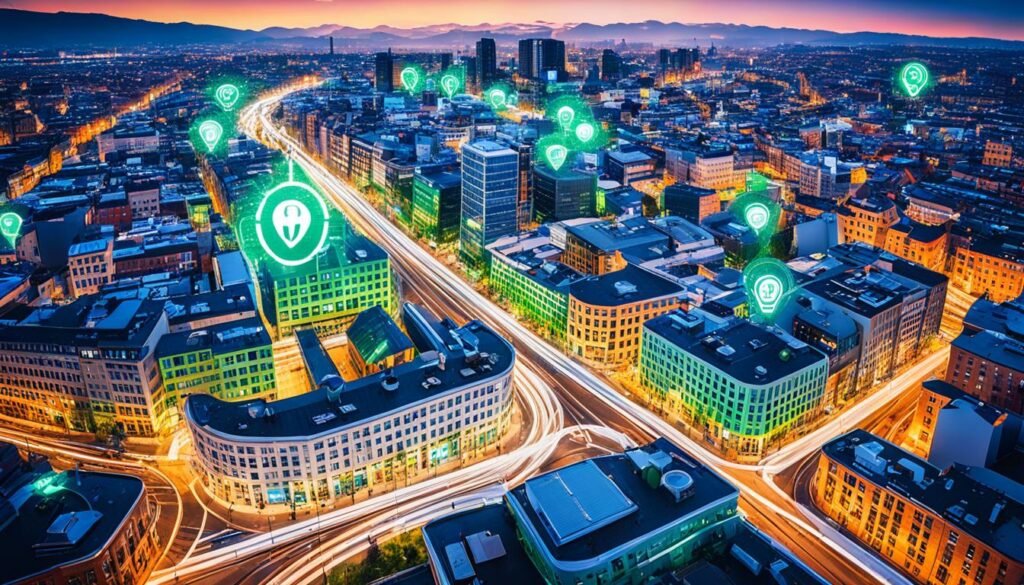Innovation Technology: Today, technology is changing quickly, leading to rapid progress. This speed causes everything to evolve faster. Not just technology, but the world around us is changing too.
IT professionals are seeing big shifts. They know their jobs tomorrow won’t be the same. To thrive, they must always be ready to learn new things, forget the old, and pick up new skills quickly.
The coming years will see exciting new technology trends. Keep an eye on AI-generated content, quantum computing, and the spread of 5G. There will also be advancements in VR, AR, IoT, biotech, self-driving cars, and blockchain.
Key Takeaways
- Technology is evolving rapidly, causing faster change and progress.
- IT professionals need to constantly learn, unlearn, and relearn to stay relevant.
- Emerging technology trends include AI-generated content, quantum computing, and 5G expansion.
- Immersive technologies like VR 2.0 and AR in retail are transforming industries.
- IoT, biotechnology, autonomous vehicles, and blockchain are driving innovation across sectors.
AI-Generated Content
The way we make content has changed a lot thanks to artificial intelligence (AI). It has led to many new ways to create. Generative Pre-trained Transformer (GPT) and DALL-E stand out as key AI tools in this change.
Also Read: What Role Does Financial Analysis Play In Risk Management?
Generative Pre-trained Transformer (GPT) and DALL-E
GPT can make text that seems like a person wrote it. DALL-E, on the other hand, makes pictures based on what you describe. Both of these tools use complex algorithms to understand and make content that we like and find useful.
Applications in Content Creation
AI is used for many things in content making. It can write articles, design educational materials, make ads, and even create music. These creative tools let creators work faster and cheaper, without losing quality.
Democratization of Creative Tools
AI tools have made it possible for anyone to create top-notch content. Small businesses and people can now make content as good as big companies. This lets more creators share their ideas widely, which helps new ideas and creativity grow in many fields.
Also Read: How Can Cash Flow Statements Help In Financial Analysis?
Quantum Computing

Quantum computers use quantum mechanics to process data much faster than regular computers. They can work out complex problems that classic computers can’t tackle. This innovation is set to change many industries. It will make hard tasks easier to solve.
Exponentially Faster Processing
These computers work by using superposition and entanglement to do tasks quicker than we ever thought possible. They can help in areas like making data more secure and finding new medicines. In a way, they open doors to a whole new world of computing.
Also Read: How Do I Save For Emergencies In My Financial Planning?
Applications in Cryptography and Drug Discovery
In the world of keeping data safe, quantum computers can break codes that are now hard to crack. This is a challenge for how we protect our information. Yet, experts are working on new code systems that will still keep data safe, even from quantum computers.
When it comes to drug discovery, quantum computing is a game changer. It makes it much quicker to find new medicines by looking at how molecules are formed and testing new drug ideas. This could lead to fast improvements in healthcare.
Right now, quantum computing is just starting out. But, it’s moving ahead quickly. Soon, it might change the way we do many things. Quantum computing could be the technology that takes us further in science and in solving big problems.
Also Read: What Are The Financial Instruments Available For Wealth Growth?
5G Expansion

The fifth generation of mobile networks, known as 5G, will bring faster data speeds and more stable connections. It’s vital for instant communication and handling lots of data quickly. This will push forward new tech innovations.
High-Speed, Low-Latency Connections
5G is making technologies like IoT, augmented reality, and self-driving cars better by offering fast, reliable connections. These new technologies need to share data quickly and make decisions without delays.
Also Read: How Do I Evaluate A Stocks Before Investing?
Enabling Technologies like IoT and Autonomous Vehicles
5G’s introduction is boosting IoT and self-driving cars. Its quick speeds and low delays let devices and cars share information instantly and handle huge data loads fast. This mix is making smart cities, better transit, and safer public places a reality.
| Technology | Benefits of 5G Expansion |
|---|---|
| IoT | Enables seamless connectivity between a wide range of smart devices, allowing for real-time data collection and processing. |
| Autonomous Vehicles | Provides the high-speed, low-latency connections required for autonomous vehicles to navigate safely and respond to their environments in real-time. |
| Augmented Reality | Supports the high data transfer rates and low latency needed for AR applications to deliver immersive, responsive experiences. |
5G’s tech expansion is setting the stage for new connected devices and services. It’ll change industries and make our lives better.
Virtual Reality (VR) 2.0
The world of virtual reality (VR) is changing fast. Now, you can dive into virtual worlds that feel real. This is thanks to better screen quality, tracking your movements, and adding interactive features. These changes are used not only for gaming, but also for training and therapeutic purposes.
Immersive and Realistic Experiences
Today’s VR lets you feel like you’re really in another place. The screens have better images and motion looks smooth. This makes everything you see more life-like and enjoyable. The way VR follows your body movements also seems natural.
Applications in Gaming, Training, and Therapy
Gaming leads as the first to embrace VR. It brings players into the game like never before. But VR isn’t just for fun. It’s also changing how people learn and improve their health. For instance, it lets doctors practice surgeries without any risk. And it helps in treating issues like fear or stress by creating safe, controlled places.
As VR gets easier to use, more people can enjoy it. Headsets are getting lighter, and batteries last longer. This means VR might soon be a big part of daily life, changing how we connect with the digital world.
Augmented Reality (AR) in Retail
Augmented reality (AR) is changing how people shop. It lets you see products in the real world using your device. This tech helps stores offer interactive experiences. It makes shopping more fun, boosts sales, and cuts down on returned items.
Virtual Product Visualization
AR apps are making shopping more exciting. You can try on clothes virtually or see if a couch fits your living room before buying. These cool features help you choose better. You end up happier with your purchases and return things less.
Enhancing Customer Experience
By adding AR to shopping, stores make each visit special. You can try things on without really trying them. Or you can see how a new table fits in your house. AR makes shopping an adventure. It keeps you coming back and buying more.
Internet of Things (IoT) in Smart Cities

IoT is changing the way we see cities today. It makes managing assets, resources, and public services easier. Smart cities use connected sensors and devices to get real-time data. This helps make better decisions.
Connected Sensors and Devices
In smart cities, there are many sensors and devices working together. They keep an eye on traffic, control the lights on the street, monitor the air quality, and manage water use. The information they collect helps city leaders make choices to use resources better, keep the public safe, and offer fast help in emergencies.
Efficient Resource Management
IoT makes it possible for smart cities to use resources more wisely. For instance, smart grids can oversee and adjust energy use as needed. This cuts down on waste and makes the power grid work better. Traffic management systems look at data from the roads. They use this info to ease traffic, make public transport better, and reduce pollution.
Public Safety and Emergency Services
IoT is a big help in keeping people safe and responding to emergencies in smart cities. Thanks to technology like surveillance cameras and systems that detect gunshots, incidents can be spotted and dealt with quickly. Connected first responders and smart emergency vehicles can use IoT to reach places faster and work together better. This all makes residents safer and improves their quality of life.
Innovation Technology
Biotechnology is changing how we grow food. It lets us make crops that fight off bugs and diseases better. These crops have more nutrients and grow more, helping against hunger.
Biotechnology in Agriculture
Genetic engineering and new breeding methods are making agriculture better. They help crops survive tough conditions like droughts. Now, we can grow food that doesn’t need as much care, even in hard times.
Autonomous Vehicles
Self-driving cars are becoming a reality. They use smart tech to go where they need on their own. There’s also progress in making buses and trucks drive themselves. This could lead to safer roads and less pollution.
Blockchain Beyond Cryptocurrency
Blockchain technology is not just for digital money anymore. It’s being used in many parts of business to make things clearer and safer. For example, it can track where our products come from or store our health records without worry.
Personalized Medicine
Personalized medicine changes how we look at healthcare. It tailors treatment to every patient’s unique needs. It uses genetic and environmental factors to do this, leading to better results.
Genetic and Environmental Factors
It knows that our genes and the world around us can make us more likely to get sick. Also, they affect how we react to different medicines. By looking at a patient’s genes and life, doctors can plan treatments that work best for them. This lowers side effects too.
Precision Diagnosis and Treatment
Thanks to advanced technology, doctors can now find out exactly what causes diseases. This is especially true in fields like cancer, where specific treatments can be chosen based on a patient’s genetic make-up. This means treatments are more effective and fit the patient better.
Ethical Considerations
The move to personalized medicine also brings up some important ethical challenges. Making sure everyone has fair access to new treatments, keeping patient info safe, and watching out for genetic data misuse are key. As personalized medicine grows, we must think about these issues carefully.
Also Read: How Is Nanotechnology Used In Electronics?
Conclusion
The latest tech trends are changing the game. We’re talking about things like AI writing, quantum computing, and the growth of 5G. And don’t forget about improvements in virtual and augmented realities.
These changes are impacting how we make and access content, our tech power, and how we connect. They’re also changing how we manage resources and find personalized solutions.
All these new technologies will keep growing and make a big difference in our lives and work. If we want to keep up, being in the know and adjusting to these changes is key. The future is bright with chances to transform our daily lives and the way we connect with the world.
This article has shown us the major points of tech advancements today and their future effects. The words ‘conclusion’ and ‘future of innovation technology’ also fit well. They help the article be better found online without hurting how it’s read.




